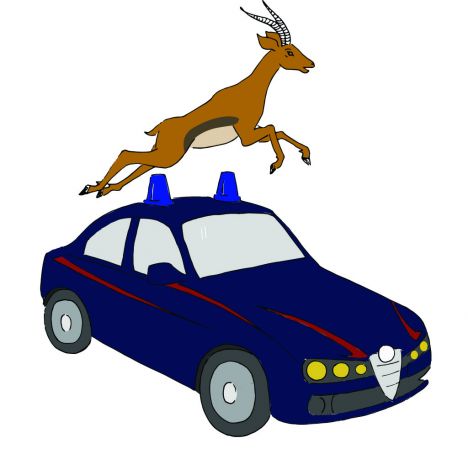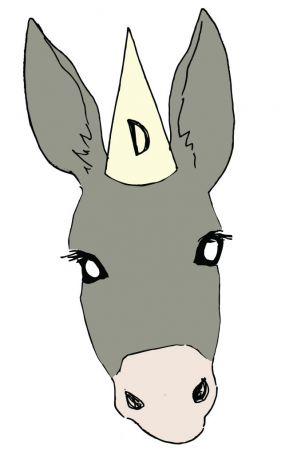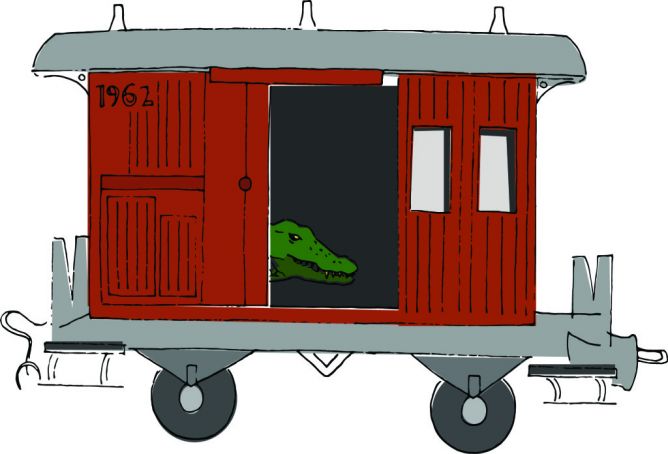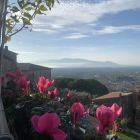Roaming the linguistic jungle between Italian and English.
Martin Bennett
Visit Rome’s Bioparco in Villa Borghese and una gazzella is a gazelle, una pantera a panther, un serpente a serpent, and so on. What you see is what you get, an Italian-English one on one. Venture outside the gates and things become more complicated: such a neat semantic fit tends to go missing.
As metaphor takes over, “signifier” and ”signified” diverge. All the more so, given that the two languages often divide up the world in wildly different ways. This article offers a brief guide to avoiding some traps and pitfalls in the semantic jungle in between.
For example, that siren echoing from a side-street is from a gazzella – not the quadruped but the four-wheeled variety, this being the word for a dark blue and red-striped patrol car of the Carabinieri. Unless, of course, it’s una pantera, the light blue equivalent used by the state police.
Zoological spectrum
They might be after a pescecane (a profiteer, not a shark), uno sciacallo (a looter, not a jackal), or uno squalo (an aggressive fleecer, not another shark). At the other end of the zoological spectrum it might be una lucciola (a prostitute, not a firefly), or perhaps topi (mice), whether d’appartamento, d’albergo or d’auto, to name three types of thief (in contradistinction to topi di biblioteca, or harmless bookworms.)

The gazzella’s and/or pantera’s prey may even be a mafia boss: O’mussuto (the codfish), so named in Neapolitan dialect for his pale skin; or maybe O’ lupo (the wolf) for his triangular face, or – biggest catch of all – O’capitone (great eel) for his slipperiness in wriggling out of trouble.
Roberto Saviano
All are mentioned by Italian anti-mafia writer Roberto Saviano in a La Repubblica article on criminal nomenclature, but with the proviso: “Behind the ridiculous and ferocious names lurk powers anything but laughable, plus communication skills exploiting popular fantasy.” This is what one might expect of la piovra (octopus or devilfish) as the criminal organisation, be it Cosa Nostra, the camorra or the ‘ndrangheta, seeks out cracks in the system to extend its reach.
Lexical symbiosis between zoology and transport continues in the loanword bulldozer, which is as easily understood as the Jumbobus that appeared in a recent headline featuring the same ending up against a tree on Via Cristoforo Colombo. Coccodrillo (crocodile), however, could also be a railway wagon, bisonte (bison) a large lorry, and muletto (little mule) a forklift truck or spare family car rather than a beast of burden, while somaro (donkey) is also a dunce.

Through no fault of their own, animals have thus been co-opted to lambast a whole gamut of all-too-human faults, failings and vices. An easier way of pointing the finger. Pot calling the kettle black. To put it in Italian, it’s more a case of Il bue che dà del cornuto all’asino, the ox blaming the ass for its horns, the sign of a cuckold. Poor animals again, so we have oca giuliva for a silly goose. Rather ungrateful to the species which, up on the Capitoline hill, once saved Republican Rome from falling to the Gauls!
By the same token, ocaggine (goose behaviour) is nonsense, while una papera (duck) or un granchio (crab – choose your animal) is a blunder. Lumacone (slug) is more likely a slime-ball, an archetype for hypocrisy rather than slowness. Farfalla (butterfly) is, transferred to humans, the less complimentary “flibbertigibbet”. [Nor need lucciole be fireflies: “Nocturnal peripatetics, they stand in public thoroughfares, near street fires. Once they were insects,” to quote literary critic Giuseppe Pontiggia: people standing by street fires, in other words prostitutes, not people trying to keep warm by the fire.
Vittorio Sgarbi and goats
Another animal to get a bad press is capra (nanny goat). In the mouth of Vittorio Sgarbi, eminent art critic and arguably not so eminent TV polemicist and provocateur, Capre, capre, capre! has become a trademark insult directed at his opponents. One result is that the Associazone italiana difesa animali e ambiente recently tried to take him to court for “incitement to maltreatment of goats”.
One might wonder whether dictionary-makers with entries offending nigh every beast in creation might risk a whole class action in this regard. The custom goes way back: Herodotus describes how one King Cleithenes changed the name of the Dorian tribes…The names he chose were derived from the words for “donkey” and “pig”. This applied to all tribes except his own, which he named “Archelai – rulers of the people” – after his own royal office.
Raw deal for pigs
Without any pig being consulted on its intellectual property rights, porcellum was the name given to an electoral law of questionable fairness (that was subsequently declared unconstitutional) sponsored by Lega Nord politician Roberto Calderoli – and it was Calderoli himself who later admitted the law was “a pig’s mess”. Porchetta, fresh from Ariccia, might be a delicacy at lunch time, yet porcherie and/or porcate both signify dirty tricks. Porco cane or porca vacca double the pejorative, while Tuscans are famous for even more blasphemously taking the poor pig’s name in vain.
In politics the owl – in English associated, via the goddess Athene, with wisdom – doesn’t escape a slur either, as in prime minister Matteo Renzi’s references to gufi sobillatori – not wise but snide instigators in the dark. Anything but pappagalli (parrots), catcallers or what we might nowadays term molesters, practitioners of pappagallismo.
Un cane sciolto (a dog off the lead) is a politician crossing party lines. Outside parliament or in, pidocchio (flea) denotes a skinflint, pidocchio rifatto (facelifted flea) an upstart or “lousy” parvenu, reuniting the common English adjective with its etymological origin. A pidocchietto, meanwhile, is, to cite a mini-Baroque masterpiece of lexicography, “un cinema di infame ordine, preferito dalla schiuma della malavita e dei cercatori di intimità particolari”, or a cinema frequented by criminal dregs and those seeking particular intimacy (Giuliano Malizia, Piccolo Dizionario Romanesco). Enough said.
Latin influences
Proverbs also provide surprises. Some, borrowed from Latin, are directly understandable. Others though approach the same human truth from zoologically different directions. Something totally outside the majority, known in both English and Italian by the Latin term rara avis or rare bird, can also be in Italian una mosca bianca (white fly). We make mountains out of molehills, but Italians make an elephant from a fly – Fare di una mosca un elefante. Our “being left empty-handed” is restare con le mosche in mano or con un pugno di mosche, with a handful of flies.
A crow is a cornacchia, no problem, until describing those wrinkles or “feet” around the eyes – in Italian also zampe di gallina (hen’s claws). Generally, Italy is more family-orientated than northern Europe. That does not stop rhyme skewing the truth towards the very negative parenti serpenti (snake relations) where English has more happily “Blood’s thicker than water”.

Smell a rat in English? In Italian C’è gatta che cova (a brooding cat). And get the wrong end of the stick? More alliteratively you’ll hear prendere lucciole per lanterne, to mistake fireflies for lanterns. A cavallo di Capodanno is not a New Year horse-ride but a period “around New Year’s Day”, horse turned zoological preposition. A cavallone, for its part, is a large wave, while a cavalletto is less likely a little horse than a hard-working metaphor for an easel or a sawhorse.
Animal metaphors and politics
And grillini (little crickets), at least on the political pages? They’re the party minions of Beppe Grillo, the loquacious comedian-turned-politician and leader of the anti-establishment Movimento Cinque Stelle (M5S). Unless they’re in your head – grilli in testa – in which case they stand for strange or outlandish ideas. And mollusco (shellfish)? “A wet”, as scorned by Margaret Thatcher, the Iron Lady.
Yes, when it comes to describing human behaviour, it’s a zoo out there. Without a dictionary to hand, non-native speakers may mistake their pigione (rent) for piccione, a pigeon. No, nothing to do with pigeon-fancying: your landlord’s talking about money. Also take care not to mistake a pig’s foot for a crowbar, or piede di porco, a crow for a grappling hook (also corvo) or a small cloud for a little lamb, or pecorella. Colomba around Easter time is probably a cake, a dove only in shape.
Formicolio is pins and needles and not as it might seem “ants in the pants”, more an affliction of the hands and feet. Pesce d’aprile is an April fool, cicala as often a chatterbox as a cicada, while gorilla, outside the zoo at least, is a night-club bouncer. Mosca can be a small beard, rana not a frog but breaststroke. Tosse d’asino is whooping cough, not a donkey’s cough, while una gatta da pelare (a cat to skin) means other fish to fry. Una bufala is not a large quadruped but a spoof or fabrication, while una gatta morta is a “sly boots”, not a dead feline.
Martin pescatore is a bird (kingfisher) not an angler, tritone less likely a sea god than a freshwater newt. Stretching to Babel and back again, from aardvark to zanzara (mosquito), the list of possible misunderstandings and embarrassments goes on and on. Hopefully this article has shortened it a little.
This article was published in the October 2016 edition of Wanted in Rome.




















